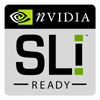Page 3
Some great features
We already touched the topic a little. A big feature for SLI gamers is the dual 8GB/s bandwidth on two graphics ports. I mean, two times x16 PCIe bandwidth here between the SPP, MCP and the GPU's is undoubtedly fantastic. Next to that, as we've already mentioned, there's another PCI-express 8x slot to be found in-between them ... which could be used for graphics cards.
Another great feature is the fact that you'll get two 1GBit Ethernet ports, which you can actually bind together as one 2 GBit/s connection. Agreed a little excessive and only 0.00001% of you will use it, but it might be a "neat" function to have on a LAN party as a server. Some other good features obviously is the support for 10 USB ports and the HDA multi-channel audio solution from Realtek.
With that being said, let's move onwards to the terminology you just read.
SLI Memory
 What is SLI (EPP) memory? DDR2 memory (actually pretty much any kind of memory) uses an SPD (Serial Presence Detect) chip to store its JEDEC certified timings and setup specifications on. Now a massive chunk of that SPD chip is being written as ZERO; meaning it's largely unused space. A couple of brainy guys figured... hmm, let's talk to some memory allies and see if we can do something with that extra space and utilize it for our new products to offer our buyers more options.
What is SLI (EPP) memory? DDR2 memory (actually pretty much any kind of memory) uses an SPD (Serial Presence Detect) chip to store its JEDEC certified timings and setup specifications on. Now a massive chunk of that SPD chip is being written as ZERO; meaning it's largely unused space. A couple of brainy guys figured... hmm, let's talk to some memory allies and see if we can do something with that extra space and utilize it for our new products to offer our buyers more options.
Since most memory is configured at JEDEC specifications, the standard timings are not exactly enthusiast presets, most of us know, we can do a heck lot more with memory timings and frequency wise then the rather safe JEDEC SPD settings tell the BIOS to fire off on your memory.
Once you overclock the system bus, your memory clock will run faster in MHz also. A higher FSB usually means that we'll need slower timings and/or different voltages, that kind of information could be stored into the SPD in several profiles.
So basically, additional non-JEDEC specified timings related towards a certain clock frequency or related to multipliers/dividers/voltages/drive strengths will be stored on that unused SPD space. This way that memory can be setup in a different way with the click of a button, or even better: Detected by your nForce 680i mainboard and set automatically.
So in short: you can tweak memory really easy, yet this is intended for the folks that have a hard time overclocking themselves. It's a reasonably fool proof method of getting the best out of your DDR2 memory with an NFORCE series 680 mainboard. Obviously you can manage memory timings and everything related to it manually as well. This is just an extra feature. Look out in the stores for memory with a "SLI Ready" logo and I honestly think this is a great feature!
Storage Features
Evidently you already noticed that the nFORCE series 680 can support six native SATA 3Gb/s drives, which previously was four. Why is that number six important you ask? Well, you can make a dual RAID 5 solution as RAID 5 requires a minimum of three drives. Obviously it is recommended that all drives on the system should be of the same size. The more drives you have on the server, the better RAID 5 will perform.
RAID 5 is the version most often recommended. Because the price of disk drives have drastically dropped, the cost of implementing RAID 5 is now within most enthusiast and companies budgets. The only time RAID 5 could fail is if two drives were to fail at the same time. The loss of disk space is basically 100 divided by the number of disk drives. With 3 drives, there is a 33% loss of disk space. With 5 drives, there is a 20% loss of disk space.
[Ed - RAID 5 takes n number of disks, stripes them together, and puts a parity section on each disk. Therefore if one drive went down, the information is still stored on another disk using parity. Performance is very close to RAID 0 / Striping]
Also I should mention the MediaShield 3.0 UI, the RAID unit/SATA connections are hot swappable, meaning you can pull out or insert the plug when the system is powered on. The minute a driver fails or will get unplugged the NVIDIA MediaShield sentinel will pop up and show you what drive/connection has gone bad.
The image shows the hard drive connector ports and provides a visual indication of the location and status of the drives as follows:
- Red rectanglered denotes a failed drive.
- Green rectanglegreen denotes a healthy hard drive.
- Yellow rectangleyellow denotes a member of a failed RAID array, but is not the cause of the failure.
- No color rectangleunconnected ports have no visual indication.
And now then there is the power of RAID 5... if one of the drives fails, the system can continue to run by just writing to one drive. Since you now have swappable drives, you could pull out the bad drive, plug in a new one and the system is back to its normal state. So you have the media shield alerting you what drive is broken, without disabling the system you swap the driver and bam, it's rebuilding the storage array.
Pretty cool stuff as you can now setup two RAID 5 units.
